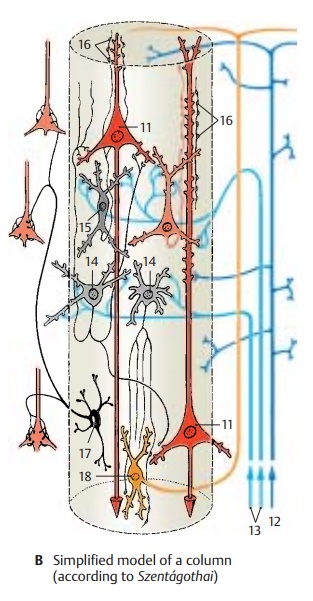Chapter: Human Nervous System and Sensory Organs : Telencephalon
Neocortex: The Module Concept
The Module Concept
The
results of histological and electrophysi-ological studies have made it possible
to de-sign models in which the described cell types are organized in a
functional group. The vertical column is conceived as a mod-ule, that is, as a
group of elements forming a functional unit. The efferent elements of the column are the pyramidal cells (B11).
Their axons either run to other cortical columns, where their terminal
ramifications end at the spines of other pyramidal cells, or they run to
subcor-tical groups of neurons. The numerous axoncollaterals (A4) terminate at the pyramidal cells of
nearby columns.

There
are two kinds of afferent fibers:
the association fibers from other columns and the specific sensory fibers from
peripheral sensory areas. In every layer the association fibers (B12)
give off branches that terminate at the spines of pyramidal cells. They ascend
to the molecu-lar layer, where they branch into horizon-tally running fibers.
The latter have synaptic contacts with apical dendrites within a radius of 3
mm. The excitation transmitted by them reaches far beyond the column; however,
it remains weak because the num-ber of synaptic contacts is limited. The specific fibers (B13) terminate in layer IV oninterneurons (B14), primarily on the cells with two dendritic trees (B15). The axons of the latter ascend
vertically along the apical dendrites of pyramidal cells and form syn-apses
with their spines (B16). These
series of synapses result in powerful transmission. The basket cells (B17),
which are inhibitory interneurons, send their axons to the pyra-midal cells of
adjacent columns and inhibit them, thereby restricting the excitation. The
basket cells themselves are activated by re-current collaterals of the
excitatory pyra-midal cells. The axons of Martinotti’s cells (B18) ascend to the molecular layer
where they form branches.
The
number of neurons per column is esti-mated to be 2500, approximately 100 of
which are pyramidal cells. It should be con-sidered, however, that a vertical
column is not a clearly defined histological entity. Possibly, it does not
represent a permanent morphological unit but rather a functional unit, which
forms and disintegrates accord-ing to the level of excitation.
Related Topics